Review of Your Previous Knowledge
Question 1.
How do electric appliances work?
Answer:
Electrical appliances work due to the electric force. Electrical force works in displacing the charges. Electric force is independent of the state of rest or the motion of the charged particle. Electric motor, washing machine are some of the examples of electric appliances.
Question 2.
How do electromagnets work?
Answer:
An electromagnet acquires the magnetic properties only when electric current is passed through the solenoid. Once the current is switched off, it almost loses its magnetic properties as retentivity of soft iron is very low. The strength of the electromagnet depends upon number of turns per unit length of the solenoid and the current through the solenoid.
Question 3.
Is there any relation between electricity and magnetism?
Answer:
The first evidence that there exists such a relationship between electricity and magnetism was observed by Oersted. When current carrying conductor was parallel to the axis of the needle, and the needle was deflected. This was much against his expectations. On reversing the direction of the current the needle moved in opposite direction.
Question 4.
Can we produce magnetism from electricity?
Answer:
We can produce magnetism from electronic current. Ampere with his Ampere’s swimming rule explained the direction of electric current and the deflection of magnetic needle.
Improve Your Learning
Question 1.
Are the magnetic field lines closed? Explain. (AS1)
Answer:
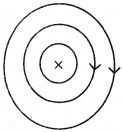
- Magnetic field lines are closed.
- If we observe the field lines formed by a current carrying straight wire, circular field lines are formed. They are closed circles.
- If we observe the field lines by a current carrying solenoid the field lines out side the solenoid are continuous with those inside.
- Thus the magnetic field lines are closed loops.
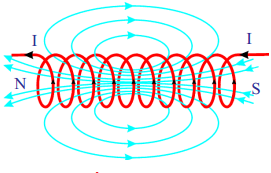
Question 2.
See figure, magnetic lines are shown. What is the direction of the current flowing through the wire? (AS1)
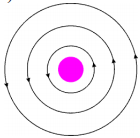
Answer:
If field lines are in anti-clockwise direction as shown in the diagram, the direction of current is vertically upwards. This can be demonstrated with right hand thumb rule.
Question 3.
A bar magnet with north pole facing towards a coil moves as shown in figure. What happens to the magnetic flux passing through the coil? (AS1)
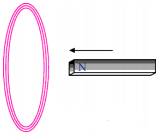
(OR)
Why would induced current be generated in the coil when a north pole of a bar magnet pushed into it ?
Answer:
If north pole of the magnet moves towards the coil, there is a continuous change of magnetic flux linked with closed coil, then current is generated in the coil.
Question 4.
A coil is kept perpendicular to page. At P, current flows into the page and at Q it comes out of the page as shown in figure. What is the direction of magnetic field due to the coil? (AS1)

Answer:
At the top, anti-clockwise direction.
At the bottom, clockwise direction.
Try This:

Take a test tube and wound minimum 50 turns of 24 guage insulated copper wire with 2cms length at the centre of test tube as shown in figure, ‘l Now solenoid is ready. Take 3cms length of iron nail and make it floats on water with appropriate foam (thermocol) on the water. Now connect the j two ends of solenoid two 3-6 volts battery eliminator and switch on the eliminator. You can observe the motion of the nail towards the solenoid. (If not move decrease the water level or increase the potential).
Try to explain motion of the nail into the water using solenoid concept.
Question 5.
The direction of current flowing in a coil is shown in the figure. What type of magnetic pole is formed at the face that has flow of current as shown in the figure? (AS1)
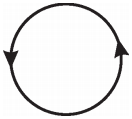
Answer:
North. Since the current in the coil flows in anti-clockwise direction, north pole is formed at the face we are watching.
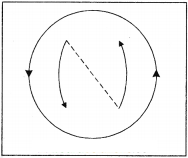
Question 6.
Why does the picture appear distorted when a bar magnet is brought close to the screen of a television? Explain. (AS1)
(OR)
Explain magnetic force on moving charge and current carrying wire.
(OR)
What happens when you bring a bar magnet near a picture of TV screen ? What inference do you conclude from this activity?
Answer:
This is due to the fact that magnetic field exerts a force on the moving charge.
TV screen Activity :
- Take a bar magnet and bring it near the TV screen.
- Then the picture on the screen is distorted.
- Here the distortion is due to the motion of the electrons reaching the screen are affected by the magnetic field.
- Now move the bar magnet away from the screen.
- Then the picture on the screen stabilizes.
- This must be due to the fact that the magnetic field exerts a force on the moving charges. This force is called magnetic force.
- The magnitude of the force is F = Bqv where B is magnetic induction, ‘q’ is the charge and v is the velocity of the charged particle.
Question 7.
Symbol ‘X’ indicates the direction of a magnetic held into the page. A straight long wire carrying current along its length is kept perpendicular to the magnetic field. What is the magnitude of force experienced by the wire? In what direction does it act? (AS1)
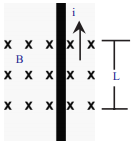
Answer:
1) Magnetic force (F) experienced by the wire with the magnitude of ILB :
Here I = Current, L = Length of the wire B = Magnetic field
2) Direction of the magnetic force (F) :
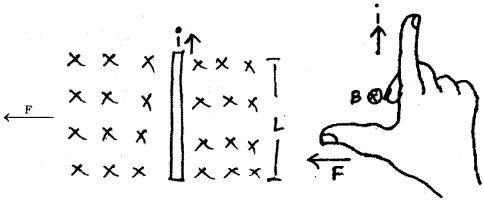
1) The direction of force can be find by using Right hand rule.
2) Fore finger → i (North)
Middle finger → B (into the page)
Thumb → F (Towards west parallel to the paper)
Question 8.
Explain the working of electric motor with a neat diagram. (AS1)
(OR)
Which device converts electrical energy into mechanical energy? Explain the working of that device with a neat diagram.
Answer:
Electric motor converts electrical energy into mechanical energy.
Electric motor:
It is a device which converts electrical energy into mechanical energy.
Principle :
It is based on the principle that a current carrying conductor placed perpendicular to the magnetic field experiences a force.
Construction :
a) Armature coil:
It contains a single loop of an insulated copper wire in the form of a rectangle.
b) Strong magnetic field :
Armature coil is placed between two permanent poles (N & S) of a strong magnet.
c) Slip-ring Commutator:
It consists of two halves (C1-and C2) of a metallic ring. The two ends of the armature coil are connected to these two halves of the ring. Commutator reverses the direction of current in the armature coil.
d) Brushes:
Two carbon brushes B1-and B2press against the commutator. These brushes act as the contact between the commutator and terminals of the battery.
e) Battery :
A battery is connected across the carbon brushes. The battery supplies the current to the armature coil.
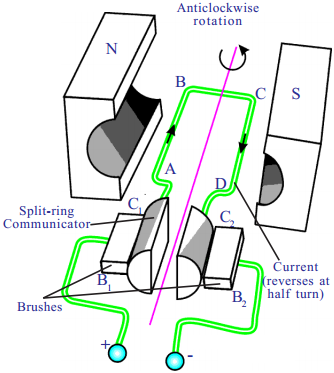
Working and Theory :
- When current flows through the coil, AB and CD experience magnetic force.
- In the arm, AB of the coil experiences a force in one direction, similarly, in CD it experiences in opposite direction.
- These two equal and opposite forces constitute a couple; which rotates the coil.
- At this position, the supply of current to the coil is cut off because contacts of commutator and brushes break.
- Hence no force acts on the arms of the coil.
- The coil will not come to rest because of rotational inertia of motion, till the commutator again comes in contact with the brushes B1 and B2.
- Now the direction of the current in the arms AB and CD is reversed.
- Then the couple again rotates in opposite direction.
- The coil of DC motor continues to rotate in the same direction. Hence electrical energy is converted into mechanical energy.
- The speed of rotation of the motor depends on
a) current through the armature
b) number of turns of the coil
c) area of the coil
d) magnetic induction.
Question 9.
Derive Faraday’slaw of induction from law of conservation of energy. (AS1)
Answer:
Faraday’s law :
Whenever there is a continuous change in magnetic flux linked with coil closed the current is generated in the coil.
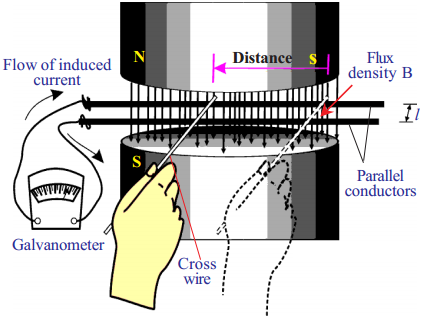
- Consider a pair of parallel bare conductors which are separated by 7′ meters.
- They are placed in uniform magnetic field of induction ‘B’ supplied by ‘N’ and ‘S’ poles of the magnet.
- A galvanometer is connected to the ends of the parallel conductors.
- We can close the circuit by touching the parallel conductor with another bare conductor which is taken in our hand.
- If we move our hand to the left, the galvanometer needle will deflect in one direction.
- If we move our hand to the right, the needle in the galvanometer moves in opposite direction.
- A current will be set up in the circuit only when there is an EMF in the circuit. Let EMF be ‘ε’.
- The principle of conservation energy tells us that this electric energy must come from the work that we have done in moving the cross wire.
Question 10.
The value of magnetic field induction which is uniform is 2T. What is the flux passing through a surface of area 1.5 m2 perpendicular to the field? (AS1)
Answer:
B = 2T ; Φ == ? ; A = 1.5 m²
We know B = Φ/A
or Φ = BA = 2 × 1.5 =3 Webers
Question 11.
An 8N force acts on a rectangular conductor 20 cm long placed perpendicular to a magnetic field. Determine the magnetic field induction if the current in the conductor is 40 A. (AS1)
Answer:
F = 8N ; l = 20 cm or 20 × 10-2 m ; B = ? ; i = 40 Amp

Question 12.
Explain with the help of two activities that current carrying wire produces magne tic field. (AS1)
(OR)
How can you verify that a current carrying wire produces a magnetic field with the help of experiment?
Answer:
Activity - 1

- Take a thermocole sheet and fix two thin sticks ol height 1cm.
- Join the two sticks with the help of copper wire.
- Take a battery, tap key and connect them in series with the copper wire which is thin.
- Keep a marine compass needle beneath the wire.
- If you press the tap key, current flows in the copper wire.
- Immediately the magnetic needle gets deflected.
- This indicates that the magnetic field is increased when current flows through the conductor.
Activity - 2
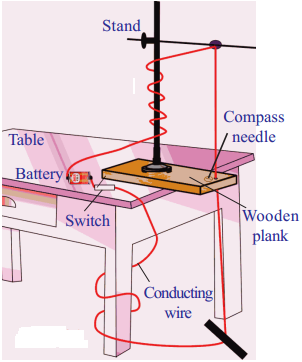
- Take a wooden plank and make a hole.
- Place the plank on the table.
- Place the retort stand on it.
- Pass copper wire through the hole.
- Connect the two ends of the wire with battery through switch.
- Place some compass needle around the hole.
- When the current flows the magnetic needle deflects.
- We can verify this by changing the direction of current.
- So we can conclude the magnetic field surrounds a current carrying conductor.
Question 13.
How do you verify experimentally that the current carrying conductor experiences a force when it is kept in magnetic field? (AS1)
Answer:
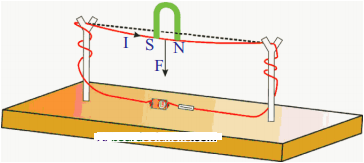
- A copper wire is passed through splits of wooden sticks.
- Connect the wire to 3 volts battery.
- Close the switch of the battery and pass the current.
- Bring the horse-shoe magnet near the wire.
- Then a force is experienced on the wire.
- Reverse the polarities of the magnet, then the direction of the force is also reversed.
- The right hand rule helps the direction of flow of current and the direction of current.
Question 14.
Explain Faraday’s law of induction with the help of an activity. (AS1)
(OR)
Write an activity which proves changing magnetic flux produces induced current in the circuit.
Answer:
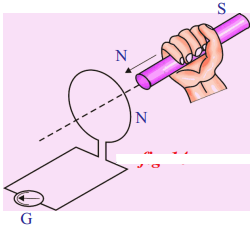
- Connect the terminals of a coil to a sensitive ammeter.
- Push a bar magnet towards the coil, with its north pole facing the coil, the needle in the galvanometer deflects.
- It shows that a current is set up in the coil.
- The galvanometer does not deflect if the magnet is at rest.
- If the magnet is moved away from the coil, the needle in the galvanometer again deflects in opposite direction.
- Further this experiment enables us to understand that the relative motion of the magnet and coil set up a current in the coil. It makes no difference whether the magnet is moved towards the coil. This is one form of Faraday’s law.
Question 15.
Explain the working of AC electric generator with a neat diagram. (AS1)
(OR)
Which device converts mechanical energy into electrical energy? Explain the working of that device with a neat diagram.
Answer:
Generator converts mechanical energy into electrical energy.
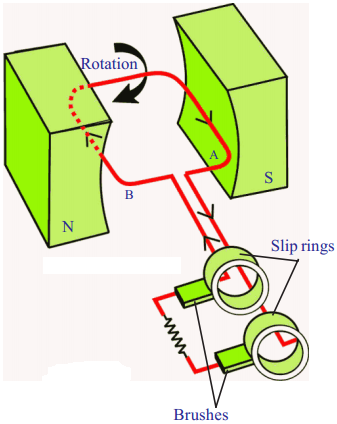
- As armature is rotated about an axis, the magnetic flux linked with armature changes. Therefore, an induced current is produced in the armature.
- If the armature rotates in anti-clockwise direction, from Flemming’s right hand rule the direction of current and deflection of the coil are noted.
- Alter armature has turned through 180°, it occupies another position.
- By applying Flemming’s right hand rule we can find the direction of current and deflection of the needle.
- Hence we can conclude the induced current is alternating in nature.
Question 16.
Explain the working of DC generator with a neat diagram. (AS1)
Answer:
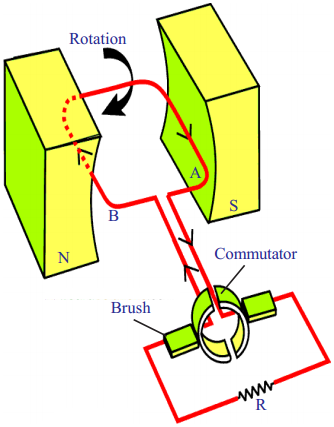
- The principle and working of D.C generator is same as that of AC generator except that in place of slip – rings as sliding contacts, we have a slip-ring or a commutator.
- In a slip ring, there are two half rings.
- The ends of armature coil are connected to these rings and these rings rotate the armature.
- By using slip-ring, the direction of induced current does not change in the external circuit throughout the complete rotation of the armature. In other words, the current in the external circuit always flows in the same direction. Hence the induced current is unidirectional.
Question 17.
Rajkumar said to you that the magnetic field lines are open and they start at north pole of bar magnet and end at south pole. What questions do you ask Rajkumar to correct him by saying “field lines are closed”? (AS2)
Answer:
- If the magnetic field lines start at north pole and end at south pole, where do the lines go from south pole?
- What is happening within the bar magnet?
- Are the magnetic field lines passing through bar magnet?
- What is the direction of magnetic field lines inside the bar magnet? (Recall the solenoid activity).
- Can you say now, that the magnetic field lines are open?
Question 18.
As shown in figure, both coil and bar magnet move in the same direction. Your friend is arguing that there is no change in flux. Do you agree with his statement? If not, what doubts do you have? Frame questions about the doubts you have regarding change in flux. (AS2)
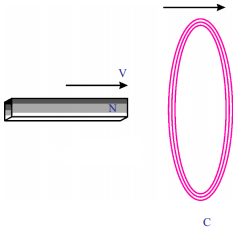
Answer:
- What happens if both magnet and coil move in same direction?
- What happens if both magnet and coil move in opposite direction?
- What is the direction of the current in the coil?
- If both move in same direction, is there any linkage of flux with the coil?
- When ‘N’ pole is moved towards the coil what is the direction of current?
- If magnet is reversed, what is the direction of current in the coil?
Question 19.
What experiment do you suggest to understand Faraday’s law? What items are required? What suggestions do you give to get good results of the experiment? Give precautions also. (AS3)
Answer:
Aim :
To understand Faraday’s law of induction.
Materials required :
A coil of copper wire, a bar magnet, Galvanometer, etc.

Procedure :
- Connect the terminal of a coil to a sensitive galvanometer as shown in the figure.
- Normally, we would not expect any deflections of needle in the galvanometer because there is to be no electromotive force in this circuit.
- Now if we push a bar magnet towards the coil, with its north pole facing the coil, we observe the needle in the galvanometer deflects, showing that a current is set up in the coil.
- The galvanometer does not deflect if the magnet is at rest.
- If the magnet is moved away from the coil, the needle in the galvanometer again deflects, but in the opposite direction, which means that a current is set up in the coil in the opposite direction.
- If we use the end of south pole of a magnet instead of north pole in the above activity, the deflections are exactly reversed.
- This experiment proves “whenever there is a continuous change of magnetic flux linked with a closed coil, a current is generated in the coil”.
Precautions :
- The coil should be kept on an insulating surface.
- Bar magnet should be of good magnetic moment.
- The centre of the galvanometer scale must be zero.
- The deflections in the galvanometer must be observed while introducing the bar magnet into the coil and also while withdrawing it.
Question 20.
How can you verify that a current carrying wire produces a magnetic field with the help of an experiment? (AS3)
Answer:
Experiment:
- Take a thermocole sheet and fix two thin wooden sticks of height 1cm.
- These sticks are joined with the help of a copper wire.
- Connect battery and tap key to this copper wire.
- Place a magnetic compass beneath the wire.
- Now press the tap key and allow the current through the wire. It is observed that magnetic needle deflects.
- If you change the direction of the current, the direction of deflection of needle also changes.
- So we can say current carrying conductor produces magnetic field.
Question 21.
Collect information about generation of current by using Faraday’s law. (AS4)
Answer:
Faraday’s law is useful in generation of current.
- According to this law, the change in magnetic flux induces EMF in the coil.
- Fie also proposed electromagnetic induction.
- Electromagnetic induction is a base for generator, which produces electric current.
- Transformer also works on the principle of electromagnetic induction, which is helpful in transmission of electricity.
- Hence Faraday’s law is used in the generation and transmission of current.
Question 22.
Collect information about material required and procedure of making a simple electric motor from internet and make a simple ntotor on your own. (AS4)
Answer:
Aim :
Preparation of a simple electric motor.
Material requried :
A wire of nearly 15 cm, 1.5v Battery, Iron nail, strong magnet, paper clip.

Procedure:
- Attach the magnet to the head of the iron nail.
- Attach a paper clip to the open end of the magnet.
- Now attach the other end of the nail (Free end) to the cap (positive terminal) of the battery.
- Now connect the negative terminal of the battery and the head of the iron nail through a wire.
- We observe that the paper clip rotates.
Another model:
Materials required :
1.5 m enamelled copper wire (about 25 gauge), 2 safety pins,
1.5 v battery, magnets, rubber bands or bands cut from cycle tube.

Procedure :
- Wind copper wire on the battery nearly 10 – 15 turns to make a coil.
- Remove the coil and fix the ends as shown in the figure.
- Scrape the insulation com¬pletely on one end of the coil.
- Scrape the insulation on top, left and right of the other end. The bottom should be insulated.
- Now complete the electric mo¬tor as shown in the figure. “5
Question 23.
Collect information of experiments done by Faraday. (AS4)
Answer:
Experiment - 1

- Connect the terminals of a coil to a sensitive galvanometer as shown in the figure.
- Normally, we would not expect any deflection of needle in the galvanometer because there is no EMF in the circuit.
- Now, if we push a bar magnet towards the coil, with its north pole facing the coil, the needle in the galvanometer deflects, showing that a current has been set up in the coil, the galvanometer does not deflect if the magnet is at rest.
- If the magnet is moved away from the coil, the needle in the galvanometer again deflects, but in the opposite direction, which means that a current is set up in the coil in the opposite direction.
- If we use the end of south pole of a magnet instead of north pole, the results i.e., the deflections in galvanometer are exactly opposite to the previous one.
- This activity proves that the change in magnetic flux linked with a closed coil, produces current.
- From this Faraday’s law of induction can be stated as “whenever there is a continuous change of magnetic flux linked with a closed coil, a current is generated in the coil”. This induced EMF is equal to the rate of change of magnetic flux passing through it.
Experiment - 2
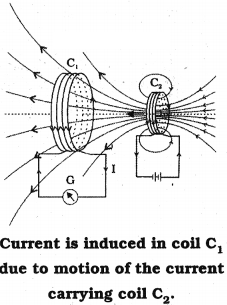
- Prepare a coil of copper wire C1and connect the two ends of the coil to a galvanometer.
- Prepare another coil of copper wire similar to C2and connect the two ends of the coil to a battery via switch.
- Now arrange the two coils C1and C2nearby as shown in the figure.
- Now switch on the coil C2. We observe a deflection in the galvanometer connected to the coil C1.
- The steady current in C2produces steady magnetic field. As coil C2is moved towards the coil C1the galvanometer shows a deflection.
- This indicates that electric current is induced in coil C1.
- When C2is moved away, the galvanometer shows a deflection again, but this time in the opposite direction.
- The deflection lasts as long as coil C2is in motion.
- When C2is fixed and C1is moved, the same effects are observed.
- This shows the induced EMF due to relative motion between two coils.
Question 24.
Draw a neat diagram of electric motor. Name the parts. (AS5)
Answer:

Question 25.
Draw a neat diagram of an AC generator. (AS5)
(OR)
Draw the diagram of electric generator and label its parts. A.
Answer:

Question 26.
How do you appreciate the Faraday’s law, which is the consequence of conservation of energy? (AS6)
Answer:
- Law of conservation of energy says energy neither be created nor be destroyed, but can be converted from one form to another.
- Faraday’s law says whenever there is a continuous change of magnetic flux linked with a closed coil, a current is generated in the coil. This induced EMF is equal to the rate of change of magnetic flux passing through it.
- We have to do some work to move the magnet through a coil. This work produces energy.
- This energy is converted into electrical energy in the coil.
- In this way conservation of energy takes place in electromagnetic induction.
Question 27.
How do you appreciate the relation between magnetic field and electricity that changed the lifestyle of mankind? (AS6)
Answer:
- Changing life style of mankind is a result of many inventions, utilising a lot of scientific principles.
- Scientists all ways going on searching for new principles and new applications to make our life more comfortable.
- If you consider electricity, right from amber stone to nuclear power, so many changes have been incorporated.
- The idea of Oersted and Faraday that current carrying wire produces electricity and electromagnetic induction, enable us to use electric motors, generators, fans, mixers, grinders, induction stoves, etc.
- All these appliances makes our life more comfortable. Hence Faraday and Oersted rendered a lot of servies in this field.
- Hence, I appreciate the relation between magnetic field and electricity that changed the life style of mankind.
So if current is more, induction is also more.
Question 28.
Give a few applications of Faraday’s law of induction in daily life. (AS7)
Answer:
Applications:
The daily life applications of Faraday’s law of induction are
- Generation of electricity
- Transmission of electricity
- Metal detectors in security checking
- The tape recorder
- Use of ATM cards
- Induction stoves
- Transformers
- Induction coils (spark plugs in automobiles)
- Break system in railway wheels
- AC and DC generators
- Windmills, etc.
Question 29.
Which of the various methods of current generation protects the nature well? Give examples to support your answer. (AS7)
Answer:
Windmill :
- Electricity is produced when an armature of a generator rotates between two poles of a strong magnet.
- Whereas when wind falls on the wheel of a windmill, it rotates. So the armature of the generator rotates between two poles of a magnet along with the rotation of the wheel of the windmill.
- Thus electric current is produced.
- This is how, KE of the wind is converted into electric energy.
Advantages :
Wind energy produces no smoke and no harmful gases. So this form of energy is pollution free or environment-friendly.